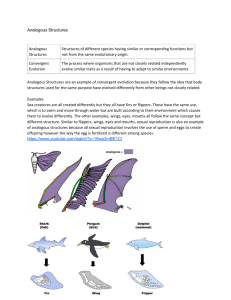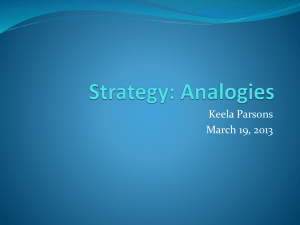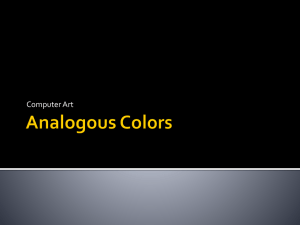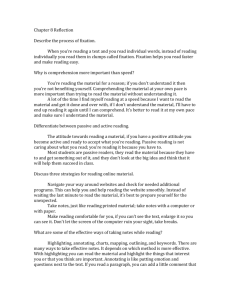Innovation Skills for Tomorrow’s Sustainable Designers*
advertisement
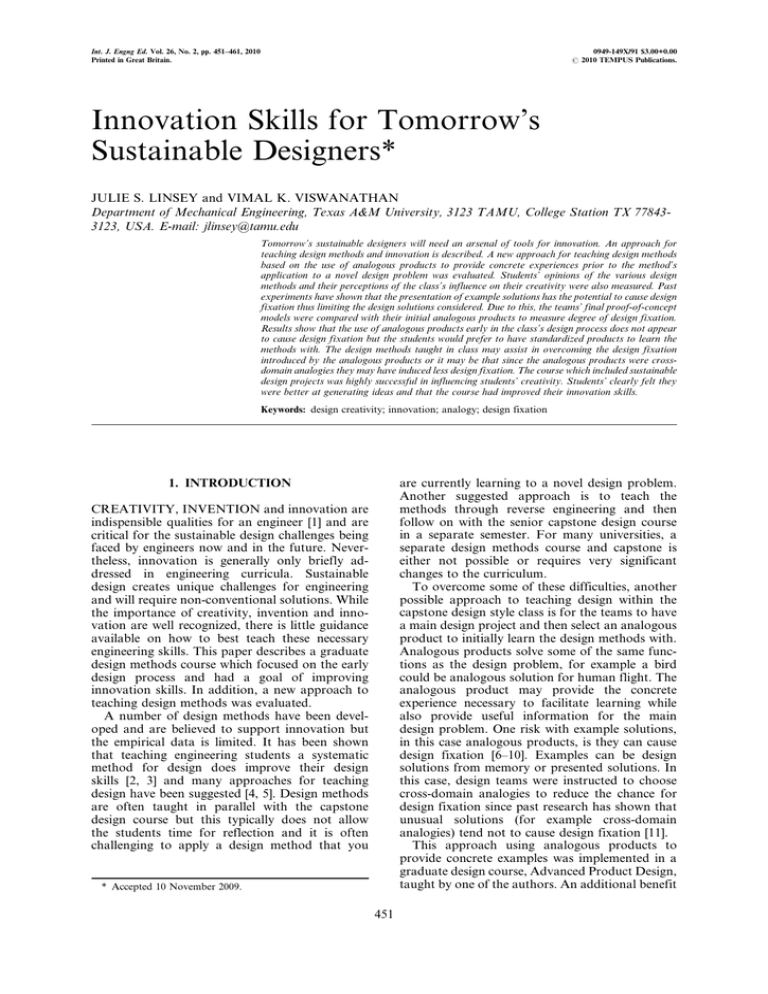
Int. J. Engng Ed. Vol. 26, No. 2, pp. 451–461, 2010 Printed in Great Britain. 0949-149X/91 $3.00+0.00 # 2010 TEMPUS Publications. Innovation Skills for Tomorrow’s Sustainable Designers* JULIE S. LINSEY and VIMAL K. VISWANATHAN Department of Mechanical Engineering, Texas A&M University, 3123 TAMU, College Station TX 778433123, USA. E-mail: jlinsey@tamu.edu Tomorrow’s sustainable designers will need an arsenal of tools for innovation. An approach for teaching design methods and innovation is described. A new approach for teaching design methods based on the use of analogous products to provide concrete experiences prior to the method’s application to a novel design problem was evaluated. Students’ opinions of the various design methods and their perceptions of the class’s influence on their creativity were also measured. Past experiments have shown that the presentation of example solutions has the potential to cause design fixation thus limiting the design solutions considered. Due to this, the teams’ final proof-of-concept models were compared with their initial analogous products to measure degree of design fixation. Results show that the use of analogous products early in the class’s design process does not appear to cause design fixation but the students would prefer to have standardized products to learn the methods with. The design methods taught in class may assist in overcoming the design fixation introduced by the analogous products or it may be that since the analogous products were crossdomain analogies they may have induced less design fixation. The course which included sustainable design projects was highly successful in influencing students’ creativity. Students’ clearly felt they were better at generating ideas and that the course had improved their innovation skills. Keywords: design creativity; innovation; analogy; design fixation are currently learning to a novel design problem. Another suggested approach is to teach the methods through reverse engineering and then follow on with the senior capstone design course in a separate semester. For many universities, a separate design methods course and capstone is either not possible or requires very significant changes to the curriculum. To overcome some of these difficulties, another possible approach to teaching design within the capstone design style class is for the teams to have a main design project and then select an analogous product to initially learn the design methods with. Analogous products solve some of the same functions as the design problem, for example a bird could be analogous solution for human flight. The analogous product may provide the concrete experience necessary to facilitate learning while also provide useful information for the main design problem. One risk with example solutions, in this case analogous products, is they can cause design fixation [6–10]. Examples can be design solutions from memory or presented solutions. In this case, design teams were instructed to choose cross-domain analogies to reduce the chance for design fixation since past research has shown that unusual solutions (for example cross-domain analogies) tend not to cause design fixation [11]. This approach using analogous products to provide concrete examples was implemented in a graduate design course, Advanced Product Design, taught by one of the authors. An additional benefit 1. INTRODUCTION CREATIVITY, INVENTION and innovation are indispensible qualities for an engineer [1] and are critical for the sustainable design challenges being faced by engineers now and in the future. Nevertheless, innovation is generally only briefly addressed in engineering curricula. Sustainable design creates unique challenges for engineering and will require non-conventional solutions. While the importance of creativity, invention and innovation are well recognized, there is little guidance available on how to best teach these necessary engineering skills. This paper describes a graduate design methods course which focused on the early design process and had a goal of improving innovation skills. In addition, a new approach to teaching design methods was evaluated. A number of design methods have been developed and are believed to support innovation but the empirical data is limited. It has been shown that teaching engineering students a systematic method for design does improve their design skills [2, 3] and many approaches for teaching design have been suggested [4, 5]. Design methods are often taught in parallel with the capstone design course but this typically does not allow the students time for reflection and it is often challenging to apply a design method that you * Accepted 10 November 2009. 451 452 J. S. Linsey and V. K. Viswanathan of analogous products is they can prevent cheating on reports and homework since every student has a different analogous product. This paper reports on initial data measuring this approach’s effectiveness. If effective, it was planned that this type of approach would be implemented in the undergraduate design class. The following research questions are addressed: . How effective is initially applying the design methods to a concrete analogous product for teaching engineering design methods while at the same providing applicable design knowledge for students’ design projects? – To what extent do the initially selected analogous products cause the design teams to fixate on those solutions? . To what extent do the graduate students, some of whom have industrial experience, perceive the methods to be valuable and do they expect to use them in the future? . To what extent do the students perceive that the design methods taught are more valuable for design problems that require innovative solutions? 2. BACKGROUND: DESCRIPTION OF ADVANCED PRODUCT DESIGN Advanced Product Design is a graduate mechanical engineering course focused on teaching engineering innovation with a broad range of methods for enhancing creativity throughout the early phases of design from identifying the opportunity through creating proof-of-concept prototypes (see www1.mengr.tamu.edu/i-dreem/courses.html for the complete syllabus and Table 1). The course used Otto and Wood [12] as the main text but was supplemented with additional methods. The course began with the students being presented with methods for identifying design problems with the potential for innovation [13, 14]. Students then selected a design problem from the problems they identified and a list provided by the instructor which included service-learning projects. Four of the course projects sought to develop cocoa processing equipment for a community service group in Guatemala, As Green as It Gets [15]. Three teams sought solutions to grind cocoa into a very fine powder and one team focused on separating the cacao nib from the hull through a winnowing process. Two more teams worked on a kiosk design for teaching people in rural areas about diabetes; two teams and one individual developed their own design problems. Most of these projects are service-learning, sustainable projects that force the students to consider the social and ethical impact of their designs thus also teaching them to be global citizen. These are identified as key skills required by future engineers [1]. After selecting their design problem, teams were asked to intuitively list analogous products and then also taught the WordTree Design-by-Analogy Method [16, 17] to identify additional analogous products. From this set, teams selected one analogous product per team member to initially apply each design method prior to attempting to apply it to their design problem. The students then moved through the early phases of the design process from identifying the customer needs and functional decomposition, to a variety of techniques for idea generation including TRIZ and 6-3-5. The course ended with proof-of-concept prototypes. Each team was required to select one analogous product and to create one proof-of-concept prototype per team member. The following learning objectives are central to the Advanced Product Design class: . To increase students’ engineering innovation and creativity skills. To increase the quantity, quality, novelty and variety of design solutions students are able to generate for a novel design problem. . To develop a product from identifying an opportunity for innovation to proof-of-concept models. . To be able to identify appropriate design methods for a given engineering design situation. The course is founded on educational theory. At its center, the course is a problem-based learning approach which is inherently a form of active learning. Design projects also provide opportunities for a deep understanding by reaching the highest levels of Bloom’s Taxonomy [18]. Design projects require students to create concepts based on the design methods taught and their prior fundamental engineering knowledge. They must also evaluate their design concepts to determine if further design methods should be applied and to select concepts for further refinement. The creation and evaluation provides for a deep learning of the design theory and strengthens their understanding of the fundamentals of engineering. The course also systematically progressed through Kolb’s Cycle [19, 20]. Students begin by learning the various design methods by applying them to the analogous products and then to their design problem. This provided the students with concrete experiences with the methods. As a part of the design reports, students were asked to reflect on the intention and the effectiveness of each design method. When design methods did not provide the desired results, students were encouraged to actively experiment with variations of the methods and to hypothesize why a given method was or was not effective. In addition, this class also assisted in deepening students’ understanding of fundamental engineering concepts. The conceptual designs provided an opportunity for concrete application of engineering knowledge to hypothesize how well a design concept will meet the requirements. Students then Innovation Skills for Tomorrow’s Sustainable Designers 453 Table 1. List of topics and methods in advanced product design Section Topics [12] Problem Identification & Definition. Problem Identification Methods. Breakthrough Products Problem ID [13]. POG/SET Factors [13]. Problem Statements. Black Box Models, Mission Statements. Analogous Product Identification. Intuitively Generated Analogies, WordTree Method for Analogous Products. Clarifying the Design Problem. Customer Needs, Like/Dislike Method, Articulated-Use Method, Lead-User Analysis, Activity Diagrams. Contextual Needs Assessment [21, 22]. Metaphors. Metaphors. House of Quality. QFD-Setting Targets/Specifications. Functional Modeling. Functional Models/Functional Basis. Idea Generation. Mind Mapping, 6-3-5, Brainstorming. Idea Generators, CREATE Method, Design-by-Analogy, WordTree, Morph Matrices, TIPS/TRIZ Theory of Inventive Problem Solving. Benchmarking. QFD-Benchmarking. Concept Selection. Concept Selection-Pugh, Decision Matrices. Parameter Analysis. Parameter Analysis/Back of the Envelope Calculations. Prototyping. Prototyping Methods & Materials. Design of Experiments. Measurement Theory, DOE/ANOVA for Proof-of-Concepts. Effort-Flow Analysis, Subtract and Operate. Design for X Methods. Design for Manufacturing, Design for the Environment. built proof-of-concept prototypes which required active experimentation to determine if requirements were met and reflection on the application of fundamental engineering theory when shortcomings within the design were identified. building them during idea generation [30]. No evidence for design fixation was observed but the sample sizes were small containing only seven participants in each group. In addition, Yang [31] found that student design teams with less detail in their initial prototypes produced better final designs. 3. DESIGN FIXATION A number of studies have shown that design fixation effects can occur when example solutions are introduced to participants [6, 11, 23–27]. Examples can be known solutions retrieved from memory, examples pictorially presented or existing prototypes. A few factors appear to influence design fixation, physical prototypes in the process, the commonality of the examples presented and various design methods. Uncommon solutions tend not to cause design fixation [28]; design methods such as analogies, categories of solutions and functional problem breakdown also have the potential to overcome design fixation [29]. Three studies have evaluated the effects of physical models (including prototypes) on design fixation, one was an observational and others were controlled experiments. Using an observational study of a product design team, Christensen & Schunn’s [27] found that physical models likely cause a high degree of design fixation. Once prototypes were introduced, very few design changes were made. It is possible that the introduction of prototypes was confounded with the stage of the design process but Christensen & Schunn argue against this interpretation. Another controlled experimental study compared participants either only sketching their ideas or also 4. METHOD The class contained thirty students seeking a graduate degree in mechanical engineering. The class included eight teams of 3–4 graduate students and one individual working alone. Students were strongly encouraged to work in a team and allowed to select their team and project. Student surveys and final design reports were included in the analysis. The two kiosk teams were not included in the design fixation analysis since the analogous designs were selected to be functionally similar but the project was mostly aesthetic design. The graduate students included both masters and PhDs. Over half of the class was international students with a high percentage from India. Their design experience ranged from very little design exposure as undergraduates to a few years of industrial experience. A survey question was designed to measure this, but it was not appropriately written and students included their time spent as research assistants instead of only their industrial experience. 4.1 Metrics To provide an assessment of the class and the proposed approach to teaching design by imple- 454 J. S. Linsey and V. K. Viswanathan menting analogous products, a series of measures were made. Students were surveyed to obtain their perceptions of improvements to their innovation skills and on their opinions of the various design methods. The student opinion of the methods survey was a modified version of a previously developed instrument [21, 32]. The prior instrument was developed in collaboration with an educational assessment expert. The students’ design reports were also evaluated to determine if the initial analogous products caused significant design fixation. The students’ final proof-of-concept models (one per team member so 3–4 per team) were compared to the initially selected analogous products to determine if the concepts were based on the analogous products. The teams were required to document their idea generation and design process with a focus on the sources of their final concepts. Documentation ranged from very clear graphics (Fig. 1) to verbal description that traced their process. The purpose of the students’ documentation was to encourage reflection on their learning and to assist them in evaluating the various methods. This documentation was directly used to determine if the final design concept was based on one of the initial analogous products. This was easily determined. The reports were coded by one of the authors. All analogous products and final proof-of-concept models are shown in Figs. 2 and 3. Fixation evaluation was only completed on the proof-of-concept prototypes. One team also created six preliminary tests on various forms of grinding such as using sand paper, grating, filing, etc. 4.2 Student perception of creativity and innovation skills To provide a preliminary evaluation of the class and to also provide an opportunity for students to self-assess their learning, a short idea generation activity was implemented. At the beginning and then again at the end of the semester, students spent one class period (about 45 minutes) generating ideas for a design problem. Different design problems were used each time. The quantity of ideas, quality, novelty or variety across the two sessions was not compared but will be in future classes. Following this activity at the end of the semester, students filled out a short survey collecting their perceptions of the class and its influence on their abilities. The survey was developed by one of the authors and was not pretested. It was designed to provide some information on the students’ perceptions. Fig. 1. One team’s documentation of their design process and sources of their concepts. Innovation Skills for Tomorrow’s Sustainable Designers Fig. 2. Initial analogous products and the final design concepts. 455 456 J. S. Linsey and V. K. Viswanathan Fig. 3. Initial analogous products and the final design concepts (continued). 5. RESULTS AND DISCUSSION Results from the student perception of the class’s effect on the innovation skills, student evaluations’ of the methods and measurement of the design fixation caused by requiring the teams to select analogous products provide insights into teaching design and innovation. The following sections describe the results of these evaluations. 5.1 Student perception of creativity and innovation skills The student perception of creativity and innovation skills survey demonstrates the potential for the Advanced Product Design class to enhance students’ innovation skills and to improve their confidence in this critical area. Overall student responses were very positive (Table 2) with students believing that their innovation skills had been enhanced and that they were better able to generate ideas. By the end of the class, the students were more confident in their abilities to be innovative. In addition, 95% of the students felt that the class increased their ability to solve difficult design problems (100% felt it either did not change or it increased their ability). This survey does not indicate the aspects of the class that are influencing students’ abilities but instead provides initial evidence that the students’ believe their skills are improved. Innovation Skills for Tomorrow’s Sustainable Designers 457 Table 2. Perceived changes in innovation and creativity skills Mean (Standard Deviation): 1 = Strongly Disagree, 5 = Strongly Agree Survey Question (n = 24) Generating ideas for the design problem today was easier than at the beginning of the semester.* This class has enhanced my creative ability. I am more confident in my ability to solve innovative design problems than before taking this class. This class has improved my creativity.* This class has made it easier for me to generate ideas.* The techniques taught in this class have increased my ability to generate ideas for design problems. Agree: 4.0 Agree: 3.8 Agree: 3.9 Agree: 4.0 Agree: 3.8 Agree: 4.4 (0.7) (0.5) (0.8) (0.8) (0.6) (0.2) * Questions were originally negatively phrased and were reversed scored. These results also indicate that the development of a self-efficacy scale for engineering innovation and creativity is needed. Self-efficacy is basically self-confidence for a particular skill. Based on these results it is likely that a single semester class may have a dramatic impact on students’ self-efficacy for innovation. 5.2 Student opinions of the methods Near the end of the semester a survey was done to measure students’ opinions of the value of the various design methods taught in class and to rate how likely they were to use them in the future (n = 24). In general, the students believed the methods taught to be of equal or greater value as Newton’s first law or the Bernoulli equation (Fig. 4). They also felt the methods were generally more valuable for design problems that require an innovative solution (Figs 4–6). On the average, students were generally unsure if they would use these methods in the future (Fig. 7) but the responses ranged from very likely to very unlikely. It is interesting to note that while the students’ rated the methods as valuable they were unsure if they would use them in the future. The students’ also rated methods, which are popular in industry such as TRIZ, as being unlikely to be used in the future. This is rather surprising given the popularity in industry and there are entire consulting firms dedicated to teaching this method. Students’ opinions could be due to the students’ limited exposure and experience with each of the methods. TRIZ, for example, was covered in about an hour over two class periods. 5.3 Initial analogous products: design fixation and student evaluation Design fixation is a major concern with introducing analogous products early in the design process and then consistently implementing the same product in order to learn the methods. The teams were required to select products that were relevant and analogous to the design problem under consideration. So the initially selected products did provide quality solutions to the design problem. The final concepts were compared to the initially selected analogous products and judged to either be based on an initial product or not. The teams, to assist them in evaluating the various design methods, were required to document the source of each of their final concepts. This assisted in judging if the final concepts were based on the analogous products selected at the beginning of the semester. In general, the final concepts were not based on the initially selected analogies (Fig. 8 and Figs. 2– 3). Only two of the twenty-two final concepts were based on the initial analogous products. These two concepts range from being very similar to the analogous product to much fewer features being borrowed (Figs. 2–3). Many of the final concepts did employ analogies as part of their development Fig. 4. Students’ perceived value of each method. Error bars are þ= one standard error. 458 J. S. Linsey and V. K. Viswanathan Fig. 5. Students’ value ratings for problems which require an innovative solution. Error bars are þ= one standard error. Fig. 6. For design problems that require innovative solutions, students believe most of the design methods are more effective. Error bars are þ= one standard error. Fig. 7. For most of the methods students were unsure if they would use them in the future. Error bars are þ= but the analogous products were not the initially selected analogies. The design teams were strongly encouraged to use cross-domain analogies to learn the design methods with because cross-domain analogies (uncommon solutions) tend to cause less fixation [11]. Consistent with prior research, the crossdomain analogous products appeared to cause little design fixation. Most of the selected analo- one standard error. gous products were effective solutions for the design problems. The other possibility is that the design methods are very effective for overcoming design fixation. Very limited data is available but a prior study on design fixation does indicate the methods such as design-by-analogy and functional decomposition do have potential to significantly reduce design fixation [29]. At the end of the semester during one lecture Innovation Skills for Tomorrow’s Sustainable Designers 459 Fig. 8. An example final concept based for winnowing cacao beans on an initial analogy of panning for gold [33]. Fig. 9. The majority of the teams appeared not to fixate on the initial analogies that they selected. period, the instructor directly asked the students their evaluation of implementing analogous products to learn the methods with rather than the same product for the entire class. From the discussion in class and some of the comments on the student opinions of the methods survey, it is clear the majority of the students believe it would have been better to have standardized homework rather than each person having a different product to work with. This approach will be implemented next semester. 6. LIMITATIONS OF THE STUDY This study took preliminary data on improving students’ innovation skills through a measure of student perceptions of their abilities and of the various methods. While the students’ perceptions clearly indicate they believe their skills are being improved no quantitative data were obtained. Future work will directly and quantitatively measure the students’ ability to generate ideas including their fluency, novelty and quality. This study also does not indicate which aspects of the class influence the students’ innovation perceptions or their evaluations of the design methods. Future work will need to address these. Students’ opinions are often moderated by their experiences. Limited data was taken on their past experiences. Over half of the class was international students with the majority from India. For many of the international students, this was their first exposure to design methods. Some of the students in class had a few years of industrial experience and clearly found the methods to be valuable. A survey question was included to measure industrial experience. Unfortunately, the question was not worded appropriately for graduate students and many of them included their time spent as research assistants in years of engineering work experience. These survey data contain a number of limitations including that this was a newly developed class, this was the first time the author taught this class, and the students were aware that her research was in design theory and methods. There could be some bias due to the students knowing that the professor’s research was in design methods. This would tend to cause the ratings to be more positive. The surveys being anonymous would tend to decrease this bias and a few students were very negative about the design methods in general. 7. CONCLUSIONS Many current reports on engineering education emphasize the need for students with innovation skills. How to teach the next generation of sustainable designers to be innovative is a critical question. Sustainable design projects are an effective means to emphasize sustainability as a critical consideration in engineering design while also providing an avenue for improving creativity and innovation skills. Sustainable design integrates well with and supports teaching innovation skills. 460 J. S. Linsey and V. K. Viswanathan Results indicate that students’ innovation skills can be improved during a single semester class. Survey results clearly demonstrate that the students’ found it much easier to generate ideas at the end of the semester, were more confident in their skills and believed the class had enhanced their abilities. The class covered a range of design methods and included a service-learning, semester long design project. All students successfully demonstrated the feasibility and effectiveness of their ideas through proof-of-concept models. Many of the projects focused on developing sustainable cocoa processing equipment for farmers in Guatemala. Currently, cocoa grinder equipment is being built with plans to implement the design solution in Guatemala. One goal of this paper was to evaluate an alternative approach to teach design methods. To provide a concrete example while at the same time also demonstrating the impact of the methods for innovation, this paper suggests an alternative approach. The alternative approach was to have the teams select analogous products, products which solve the same function as the design problem, to first learn the methods with prior to application to the novel design problem. The introduction of the analogous products early in the process did not cause the design teams to fixate on those solutions in their final proof-of-concepts models. The design teams considered a number of other options and generally selected final concepts that were not related to the initial products. Most of the analogous products were cross-domain analogies which cause less fixation and the methods taught in class may have assisted in overcoming any fixation caused by the analogous products. While the early introduction of analogous products does not cause significant design fixation, the students’ generally would have preferred that the methods be taught with the same product for all students rather than each student being focused on a different product. This is based on student perceptions only and their learning was not quantitatively measured. This would be a reason not to implement this approach. Design innovation can be taught. Significant questions remain on how to teach these critical skills and much further work is needed. A much deeper understanding of the factors of a class and of design methods that increase creativity and innovations skills is needed. Development of a self-efficacy scale for engineering innovation and creativity is needed. Self-efficacy is basically selfconfidence for a particular skill. Students’ confidence in their skills increased over the semester. Quantitative measurements of the increase in student innovation abilities need to be made in order to corroborate the students’ perceptions of their abilities Acknowledgements—The author would like to acknowledge Steven Ballance, for his assistance in summarizing the survey data and the Fall 2008 MEEN 601 class for their insightful feedback on the course. REFERENCES 1. National Academy of Engineering, The Engineer of 2020: Visions of Engineering in the New Century, 2004. 2. D. F. Radcliffe and T. Y. Lee, Design Methods Used by Undergraduate Engineering Students, Design Studies, 10(4), 1989, pp. 199–207. 3. G. Fricke, Successful Approaches in Dealing with Differently Precise Design Problems, Design Studies, 20(5), 1999, pp. 417–429. 4. K. L. Wood, D. D. Jensen, J. Bezdek and K. Otto, Reverse Engineering and Redesign: Courses to Incrementally and Systematically Teach Design, Journal of Engineering Education, 90(3), 2001, pp. 363–374. 5. K. Otto, K. L. Wood, M. D. Murphy and D. D. Jensen, Building Better Mousetrap Builders: Courses to Incrementally and Systematically Teach Design, ASEE Annual Conference and Exposition, 1998. 6. D. Jansson and S. Smith, Design Fixation, Design Studies, 12(1), 1991, pp. 3–11. 7. A. T. Purcell and J. S. Gero, Design and Other Types of Fixation, Design Studies, 17(4), 1996, pp. 363–383. 8. E. G. Chrysikou and R. W. Weisberg, Following the Wrong Footsteps: Fixation Effects of Pictorial Examples in a Design Problem-Solving Task, Journal of Experimental Psychology, Learning, Memory and Cognition, 31(5), 2005, pp. 1134–1148. 9. J. Moss, K. Kotovsky and J. Cagan, The Influence of Open Goals on the Acquisition of ProblemRelevant Information, Journal of Experimental Psychology: Learning, Memory, & Cognition, 33(5), 2007, pp. 876–891. 10. I. Tseng, J. Moss, J. Cagan and K. Kotovsky, The Role of Timing and Analogical Similarity in the Stimulation of Idea Generation in Design, Design Studies, 29(3), 2008, pp. 203–221. 11. M. Perttula and P. Sipila, The Idea Exposure Paradigm in Design Idea Generation, Journal of Engineering Design, 18(1), 2007, pp. 93–102. 12. K. Otto and K. Wood, Product Design: Techniques in Reverse Engineering and New Product Development, Prentice Hall, 2001. 13. J. Cagan and C. M. Vogel, Creating Breakthrough Products: Innovation from Product Planning to Program Approval, Prentice Hall, 2001. 14. T. Kelley and J. Littman, The Art of Innovation, Doubleday, 2001. 15. ‘As Green as It Gets’, http://www.asgreenasitgets.org, October 2008. Innovation Skills for Tomorrow’s Sustainable Designers 16. J. Linsey, K. Wood and A. Markman, Increasing Innovation: Presentation and Evaluation of the Wordtree Design-by-Analogy Method, ASME IDETC Design Theory and Methodology Conference, 2008. 17. J. Linsey, A. Markman and K. Wood, Wordtrees: A Method for Design-by-Analogy, 2008 American Society for Engineering Education Annual Conference, 2008. 18. D. R. Krathwohl, B. S. Bloom and B. B. Maisa, Taxonomy of Educational Objectives: The Classification of Educational Goals, Handbook Ii, Affective Domain, David McKay Co. Inc., 1964. 19. D. A. Kolb, Experiential Learning: Experience as the Source of Learning and Development, Prentice Hall, 1984. 20. J. E. Stice, Using Kolb’s Learning Cycle to Improve Student Learning, Journal of Engineering Education, 77(5), 1987, pp. 291–296. 21. M. G. Green, J. S. Linsey, C. C. Seepersad, K. L. Wood and D. J. Jensen, Frontier Design: A Product Usage Context Method, ASME Design Theory and Methodology Conference, 2006. 22. M. G. Green, C. C. Seepersad, D. J. Jensen and K. L. Wood, Design for Frontier Contexts: Classroom Assessment of a New Design Methodology with Humanitarian Applications, International Journal of Engineering Education, (accepted, 2009). 23. S. M. Smith and S. E. Blankenship, Incubation and the Persistence of Fixation in Problem Solving, American Journal of Psychology, 104, 1991, pp. 61–87. 24. T. B. Ward, Structured Imagination: The Role of Category Structure in Exemplar Generation, Cognitive Psychology, 27(1), 1994, pp. 1–40. 25. R. L. Marsh, T. B. Ward and J. D. Landau, The Inadvertent Use of Prior Knowledge in a Generative Cognitive Task, Memory & Cognition, 27(1), 1999, pp. 94–105. 26. S. Jaarsveld and C. Leeuwen, Sketches from a Design Process: Creative Cognition Inferred from Intermediate Products, Cognitive Science, 29, 2005, pp. 79–107. 27. B. T. Christensen and C. Schunn, The Relationship of Analogical Distance to Analogical Function and Pre-Inventive Structures: The Case of Engineering Design, Memory & Cognition, 35(1), 2007, pp. 29–38. 28. M. K. Perttula and L. A. Liikkanen, Structural Tendencies and Exposure Effects in Design Idea Generation, Proceedings of the ASME Design Engineering Technical Conference, 2006. 29. J. Linsey, I. Tseng, K. Fu, J. Cagan, K. Wood and C. Schunn, A Study of Design Fixation, its Mitigation and Perception in Engineering Design Faculty, ASME Journal of Mechanical Design, 2010, accepted. 30. V. K. Viswanathan and J. S. Linsey, Enhancing Student Innovation: Physical Models in the Idea Generation Process, ASEE/IEEE Frontiers in Education Conference, (2009). 31. M. C. Yang and D. J. Epstein, A Study of Prototypes, Design Activity, and Design Outcomes, Design Studies, 26, 2005, pp. 649–669. 32. M. Green, J. Linsey, C. Seepersad, K. Schmidt and K. Wood, Design for Frontier Contexts: Classroom Assessment of a New Design Methodology with Humanitarian Applications, Proceedings of the 2006 American Society for Engineering Education Annual Conference, 2006. 33. Panning for Placer Diamonds and Gold Family Fun and Adventure, http://www.poudreriverresort. com/panning_for_placer_diamonds_and.htm, April, 2009. Figures 2 and 3 are compiled from the following sources: Nelson, Stewart C., ‘Fruit Cutter and Juicer,’ U.S. 4479425 (1983). http://www.break-day.com/en/ball-mill.html, accessed 8/2009. http://www.caer. uky.edu/services/equipmentpages/coalashequip_images.html, accessed 8/2009. http://co2calculator. files.wordpress.com/2008/10/segway.jpg, accessed 8/2009. ‘Gold Prospecting’, accessed 10/2008. http://goldprice.org/gold-prospecting/2009/02/how-to-pan-for-gold.html. ‘Weivo’, accessed 8/2009. http://www.hacheviande.com/meat-mincer/walnut_parer.htm. ‘The Lesson: California History Social Science Standard. The Cotton Gin.’ 9/2008. http://score.rims.k12.ca.us/score_lessons/cotton_gin/pages/lesson.html. ‘Chefs Corner,’ accessed 8/2009. http://www.chefscorner.com/web/Reviews/powerreviews/product-reviews/4420/Small-Electrics/ Kitchen-Appliances/KitchenAid/p/272385-Pro-Line-Chefs-Blender-KPCB348P.html. ‘The Coffee Sites,’ accessed 8/2009. http://www.thecoffeesite-s.com/coffee-bean-grinders/. ‘Technology Review’. http://www.technologyreview.com/files/15307/ele_robot_x400.jpg ‘accessed 8/2009. http://media.mnginteractive.com/media/paper140/20050812_LOC_LOCAL4.jpg, accessed 8/2009. http://www.indiawaterportal.org/blog/wp-content/uploads/2008/01/img_0052.JPG, accessed 8/2009. Julie S. Linsey is an assistant professor at Texas A&M University in the Mechanical Engineering Department since 2008. She earned a Ph.D and MS in mechanical engineering from The University of Texas at Austin and a BS in Mechanical Engineering from the University of Michigan. She teaches the mechanical engineering undergraduate capstone design courses and the mechanical engineering graduate course, Advanced Product Design. Her research focus is on systematic methods and tools for innovative design with a particular focus on concept generation and design-by-analogy. She has co-authored over fifteen technical publications including two book chapters and she holds two patents. Vimal Kumar Viswanathan is a graduate student in the Mechanical Engineering Department at Texas A&M University. He did his Bachelors of Technology in Mechanical Engineering from National Institute of Technology, Calicut, India. His area of research is the effect of various representations in the engineering idea generation process. 461
